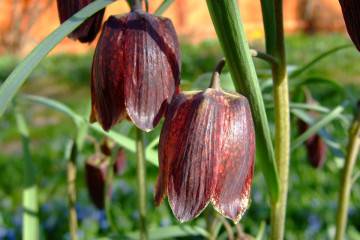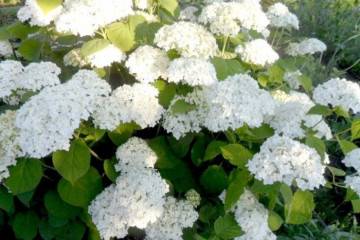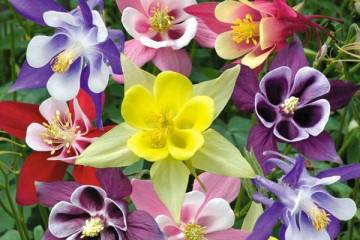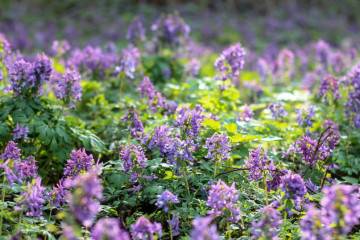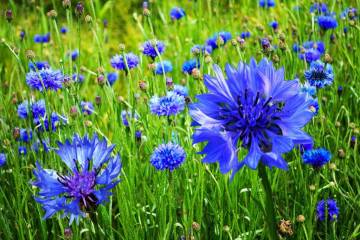Astrantia flower
Content:
Astrantia has a unique appearance - its inflorescence consists not only of petals, but also of a bract. The flower itself can delight the owner, decorating a plot or a house, because it is grown, including for a cut.
The origin and appearance of the astrantia plant
In nature today, there are about 10 species of Astrantia, they grow in the following regions:
- in the European part of Russia;
- Europe;
- Belarus;
- Ukraine;
- Moldova;
- Latvia;
- Estonia.
Astrantia flower is a perennial herb. Due to winter hardiness, it can be grown in Siberia, the Urals and other northern regions. The plant is listed in the Red Book of Russia, appeared in culture in 1597.
The plant belongs to the Umbrella family and flowering group. Grown on a cut, in a composition it can form the basis of a bouquet or complement other large flowers. When cut, retains freshness for 2 to 5 days.
Description of the flower of the plant astrantia
Depending on the species, the shrub can have a height of 15 to 90 cm, the stems are straight, poorly covered with branches and leaves. At the edges, the leaves are serrated, palmate-lobed or palmate-divided in shape. Due to the shape of the bract, the plant is also called "star".
The flowers are small, simple umbrellas are collected in inflorescences. The outer layer is the bracts, which are large leaves, painted to match the petals.
Astrantia: varieties and types
All varieties are similar to each other, the differences are only in the color of the petals, the size of the shrub and inflorescences, the required growing conditions.
Astrantia is large
Large Astrantia (Astrantia maxima) appeared in local gardens a long time ago. The inflorescence consists of a large number of small flowers on pedicels up to 2.5 cm long, which are wrapped in a bracts.
Artificially bred varieties:
- Mulen Rouge, Roma, Claret - have pink-purple petals and bract leaves, the flowering period begins at the end of June and lasts a whole month, while the brightness of the flower does not decrease until the last day of flowering.
- Snow Star, Celtic Star, Green Tapestry, Jade Lady - white-green petals and bracts, large dissected leaves give decorative effect;
- Shaggy is the most popular variety, famous for its large green twigs.
Astrantia white
White Astrantia received the title of aristocrat from the British. The appearance of the plant is delicate and fragile. In the United States, this species is a symbol of Independence Day.
This species is characterized by white, pink or burgundy flowers - depending on the variety. Florists love to work with this species because of the lush flowering of the plant, when many small flowers tend upward on long pedicels.
White Astrantia is used in bouquets as an additional flower, complementing roses, orchids, tulips or other exotic specimens.
Astrantia Moulin Rouge
Moulin Rouge has straight, slightly branched stems, reaching a height of 50 cm.The leaves are collected in a basal rosette, green, located on long petioles, palm-shaped.
The flowering period occurs at the end of June-August and lasts about 40 days. The flowers are burgundy, the diameter of the inflorescence is 4-5 cm.
Astrantia Roma
A shrub of the Roma variety grows up to 70 cm. The leaves of the plant are deeply finger-dissected, multiple pink flowers are collected in inflorescences that entwine a silvery-pink bracts. Flowering begins in late June and lasts until September.
Astrantia Major
The petals of the flowers are pale pink, the diameter of the inflorescences is up to 4-5 cm, the bracts are pale pink or light green. Large Astrantia grows in the form of spreading shrubs up to 70 cm high.
The flowering period occurs at the end of June - August and lasts 40 days.
Astrantia Shaggy
Astrantia big Shaggy is a newly introduced perennial variety. Shrub height up to 75 cm.
It blooms with its white-green petals in early July and continues to delight the eye until mid-August. The inflorescences are large enough.
The plant is distinguished by drought resistance and average frost resistance, has a high immunity to pests.
Astrantia Pink Symphony
The petals are pink-red, the petioles are long, the diameter of the inflorescence is up to 4-5 cm, wrapped in a pale pink bracts. The flowering is abundant and lush.
The unpretentious variety of Astrantia, Pink Symphony, has high drought resistance and easily tolerates frost. The height of the shrub is 75 cm, diameter 35 cm.
The pink symphony is used by florists for cut and dried flowers. In landscape design, mixborders are decorated with it, they create single and group plantings on lawns.
Astrantia Rosea
Astrantia major Rosea grows up to 70 cm in height. The leaves on the shrub are dark green, the flower petals are bright pink, the wrapper is the same bright color.
Blossoming Astrantia Rosea lasts from early June to late September. The plant is resistant to hot periods, grows in the shade and in the sun.
Astrantia Venice
Venice has dark purple flowers. The diameter of the shrub during flowering reaches 40 cm.
The plant grows in the sun and in the shade, loves fertile soils, tolerates drought and frost well.
Designers are used in single and group plantings, alpine slides, mixborders.
Astrantia Clarinet
Clarnet grows up to 55 cm in height, leaves are rare, collected in a root rosette. The shade of the flower petals is dark red. The clarinet is one of the darkest colored representatives.
The flowering period lasts from June to September, the plant loves fertile soil, grows in the sun and in partial shade. It is not whimsical in care, it develops in arid conditions and does not die in frost.
Used for cut and dry compositions.
Astrantia Diva
Astrantia major "Primadonna" blooms with dark red flowers with a paler wrapper. Used for growing in the garden and for cutting.
The height of the shrub reaches 70 cm. The leaves are palmate-lobed, bright green, collected in a basal rosette.
Astrantia variegated
It grows up to 40 cm in height, has pale pink flowers and brightly colored leaves.
Growing Astrantia from seeds
Astrantia reproduces very quickly by self-seeding. That is why in nature it covers large areas in fields and forest edges in a short time.
At home, propagation by seeds can lead to a loss of varietal characteristics. But if you follow some of the growing rules, then there is a great chance of getting copies identical to the parent.
What you need to plant seeds
During flowering, the largest and healthiest inflorescences are chosen. When the flowering period is over and the buds begin to dry out, the previously selected ones are covered with gauze so that the seeds from the boxes do not fall to the ground. Dried seeds are dried and cleaned.
Seeds are sown in the ground immediately after harvest, that is, at the end of autumn, the sprouts will appear as early as next spring.
If it is necessary to sow seeds in the spring, they are folded into a paper bag and placed on the bottom shelf of the refrigerator - thus stratification occurs. You also need to do with purchased seeds, keep in cold conditions for 2-3 months.
Growing seedlings of astrania
It all starts with preparing boxes of fertile soil and sowing seeds in them. The seed is placed on the surface and covered with soil for a few more centimeters. The boxes should be at an air temperature of 20-23 ° C, they are covered with foil or glass on top.
When shoots appear, the film is removed, and the boxes themselves move closer to the sun. After a week, the seedlings are thinned out.
When 2-3 true leaves appear on the sprouts, they dive. 10 days before planting the seedlings in the ground, hardening is carried out: every day the container with the sprout is taken out to the balcony or terrace, gradually increasing the time spent in the open area.
Astrantia: planting and care in the open field
Taking care of Astrantia is as easy as planting it. Any novice gardener will cope with the task.
Step-by-step process of planting in the garden
It is necessary to plant seedlings in open ground in late May - early June. For planting shrubs, choose a place with loose, fertile soil.
Step-by-step planting process:
- Planting holes are dug at a distance of 40 cm from each other.
- A sprout is being established.
- The pit is filled with soil, the soil is compacted.
- This is followed by abundant watering.
Watering mode
This is one of the most unpretentious plants, therefore, it does not require additional moisture, except for natural precipitation. In addition, most plant species tolerate drought well, which does not affect their growth and flowering.
After precipitation or watering, the soil around the shrub is weeded and mulched, this allows it to retain moisture for a longer time.
Fig 7 Landscape design option
Top dressing
If the flower grows in a nutritious soil, then it is enough to apply fertilizing once a season. At the beginning of spring, a complex mineral fertilizer is applied.
If the soil on the site is poor, then fertilizing is done in early spring and again in July-August, for this, potassium-phosphorus fertilizer is used. Both liquid and dry fertilizers can be used.
To make the leaves more elastic and vibrant, they can be sprayed with a solution of trace elements. This type of feeding is called foliar feeding.
Features of care during the flowering period
In order for Astrantia to bloom longer and at the same time not to reproduce on its own, dried flower stalks are cut off.
After the first wave of flowering, all peduncles are cut off - this will stimulate the growth of new flower arrows. The second bloom will be much more magnificent and beautiful.
Features of care during the rest period
The dormant period of the plant in winter.
During this time, no additional care measures are required. You can rejuvenate the old bush before the growing season by dividing it into several parts.
Preparing for winter
Preparation for wintering begins in the middle of autumn. All stems are cut to ground level. After that, the shrubs are mulched with peat or humus.
For adult plants, shelter is not required; young ones are best covered with spruce branches.
Astrantia is a gorgeous ornamental plant. Planting and caring for an Astrantia flower requires a minimum of time and effort. By planting her on the site, you can be sure that she will take all the attention for herself.






